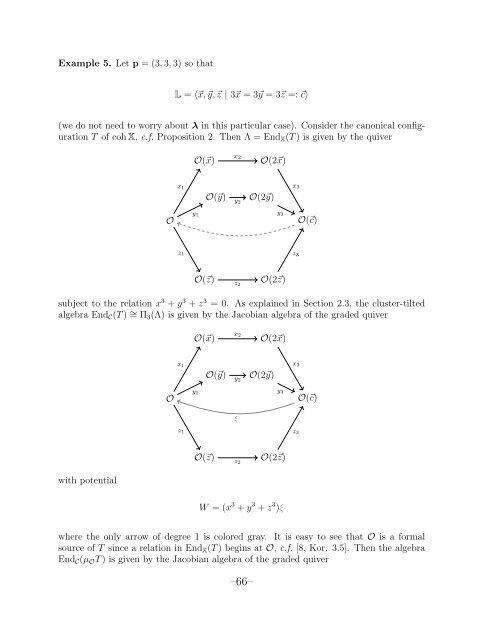Create successful ePaper yourself
Turn your PDF publications into a flip-book with our unique Google optimized e-Paper software.
Example 5. Let p = (3, 3, 3) so that<br />
L = 〈⃗x, ⃗y, ⃗z | 3⃗x = 3⃗y = 3⃗z =: ⃗c〉<br />
(we do not need to worry about λ in this particular case). Consider the canonical configuration<br />
T of coh X, c.f. Proposition 2. Then Λ = End X (T ) is given by the quiver<br />
O(⃗x)<br />
x 2<br />
O(2⃗x)<br />
O(⃗y)<br />
y 2<br />
x 1<br />
y 3<br />
O(2⃗y)<br />
x 3<br />
O<br />
O(⃗c)<br />
y 1<br />
z 3<br />
z 1<br />
O(⃗z)<br />
z 2<br />
O(2⃗z)<br />
subject to the relation x 3 + y 3 + z 3 = 0. As explained in Section 2.3, the cluster-tilted<br />
algebra End C (T ) ∼ = Π 3 (Λ) is given by the Jacobian algebra of the graded quiver<br />
O(⃗x)<br />
x 2<br />
O(2⃗x)<br />
O(⃗y)<br />
y 2<br />
x 1<br />
y 3<br />
O(2⃗y)<br />
x 3<br />
O<br />
O(⃗c)<br />
y 1<br />
z 3<br />
ξ<br />
z 1<br />
O(⃗z)<br />
z 2<br />
O(2⃗z)<br />
with potential<br />
W = (x 3 + y 3 + z 3 )ξ<br />
where the only arrow of degree 1 is colored gray. It is easy to see that O is a formal<br />
source of T since a relation in End X (T ) begins at O, c.f. [8, Kor. 3.5]. Then the algebra<br />
End C (µ O T ) is given by the Jacobian algebra of the graded quiver<br />
–66–















